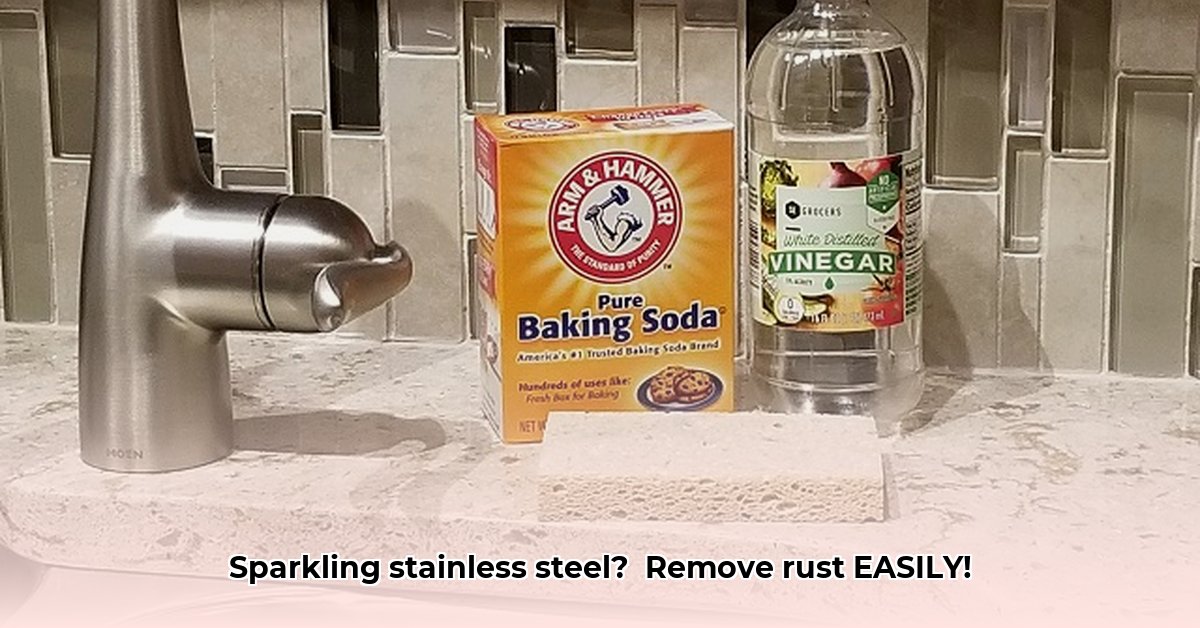Rust on stainless steel is a common issue, but don’t fret! While stainless steel is durable, it isn’t rust-proof. This guide provides simple steps to remove rust and restore your stainless steel’s shine using various effective methods, from common household solutions to more potent options. For more in-depth information, check out this helpful guide: stainless steel rust removal.
Understanding Stainless Steel Rust and Corrosion Prevention Methods
Stainless steel contains chromium, which forms a protective layer against rust. This layer can be compromised by scratches, dents, or harsh chemicals, allowing oxygen and moisture to cause rust. Before cleaning, assess the rust’s severity to choose the right method. Light surface rust can be treated with simple remedies, while persistent rust may require a stronger approach, ensuring the longevity of your appliances.
Here are some key insights:
- Chromium in stainless steel provides rust resistance through a protective layer.
- Damage to this layer allows rust to form, necessitating careful cleaning.
- Choosing the right cleaning method depends on the rust’s severity, ranging from light to heavy.
Method 1: Baking Soda Paste for Minor Rust Removal
For small, superficial rust spots, baking soda paste is an effective yet gentle solution.
- Mix it Up: Combine 1 tablespoon of baking soda with 2 tablespoons of water to create a toothpaste-like paste.
- Apply with Care: Gently rub the paste onto the rusty area along the steel’s grain, avoiding harsh scrubbing.
- Gently Scrub: Use a soft cloth or non-abrasive sponge to prevent further scratches. Circular motions can help lift the rust.
- Rinse and Repeat (Maybe): Rinse thoroughly with clean water and repeat if necessary. For stubborn spots, let the paste sit for 15-20 minutes before rinsing.
- Dry Completely: Dry the area with a soft, clean microfiber cloth to prevent future rust and water spots.
This method is safe and effective for minor rust problems, offering a great starting point for cleaning. It’s a low-cost, readily available solution that minimizes the risk of damage.
Method 2: Vinegar Soak for Persistent Rust Removal
White vinegar, a mild acid, effectively dissolves rust and is ideal for stains baking soda can’t handle. It’s particularly effective on items that can be fully submerged.
- The Soak: Submerge the rusty item in white vinegar for 2-3 hours. For larger items or stubborn rust, wrap the affected area in a vinegar-soaked cloth and let it sit overnight.
- Scrub Gently: After soaking, gently scrub away the loosened rust with a soft cloth or sponge. A toothbrush can be useful for tight corners and crevices.
- Rinse and Dry: Rinse the area thoroughly with clean water and dry it completely with a clean towel or paper towel.
Important Note: Avoid using vinegar on delicate stainless steel or areas with deep pitting for extended periods. Prolonged exposure might cause slight discoloration. Always test in an inconspicuous area first. Soaking in vinegar proves fairly effective with a success rate of up to 90% when combined with gentle scrubbing.
Method 3: Oxalic Acid for Severe Rust Stains (Use with Caution!)
For severe rust, use an oxalic acid cleaner with caution due to its potency. Bar Keepers Friend is a commonly available option.
- Safety First! Wear gloves and eye protection in a well-ventilated area. Oxalic acid can irritate skin and eyes.
- Follow Instructions: Carefully read and follow the manufacturer’s instructions on the product label, specifying the duration and scrubbing method.
- Gentle Scrubbing: Apply the cleaner to a damp cloth or sponge and gently scrub the affected area, working with the grain of the stainless steel.
- Thorough Rinse: Rinse thoroughly with plenty of clean water to remove all traces of the oxalic acid cleaner, and then allow to dry completely.
- Apply Stainless Steel Polish: After cleaning and drying, consider applying a stainless steel polish to help restore shine and protect the surface.
WARNING: Oxalic acid is toxic if swallowed or inhaled. Take appropriate safety measures! Experts say wearing gloves and eye protection decreases risk significantly. Use only as a last resort for severe rust.
Method 4: Commercial Rust Removers for Easy Rust Treatment
Many commercial rust removers are available in spray or gel form. Follow the manufacturer’s instructions carefully, paying close attention to safety precautions. Always test the product in an inconspicuous area first to ensure it doesn’t damage the stainless steel. Consider the cost-effectiveness and potential environmental impact of these products.
Prevention: Keeping Your Stainless Steel Rust-Free for Longevity
Preventing rust is easier than removing it. Implement these preventive measures:
- Regular Cleaning: Wipe down stainless steel surfaces after each use, mainly after spills, with a mild soap and water solution.
- Dry Thoroughly: Ensure surfaces are dry after cleaning, as moisture promotes rust. Use a clean, dry cloth to buff the surface.
- Avoid Abrasive Cleaners: Harsh scrubbing pads, steel wool, and cleaners containing chlorides can damage the protective layer, making it rust-prone.
- Keep Away from Other Metals: Contact with iron or other rusting metals can transfer rust to stainless steel. Avoid placing rusty items on stainless steel surfaces.
- Apply a Protective Coating: Periodically apply a stainless steel polish or protectant to create a barrier against moisture and contaminants.
Comparing Rust Removal Methods for Optimal Care
| Method | Effectiveness (Light Rust) | Effectiveness (Heavy Rust) | Safety | Cost | Time Commitment | Notes |
|---|---|---|---|---|---|---|
| Baking Soda Paste | Excellent | Fair | High | Very Low | Low | Best for minor surface rust; gentle and non-abrasive. |
| Vinegar Soak | Good | Fair | High | Very Low | Moderate | Effective for soaking smaller items; avoid prolonged exposure. |
| Oxalic Acid Cleaner | Excellent | Excellent | Moderate | Low | Moderate | Use with caution; follow instructions carefully; wear protection. |
| Commercial Rust Remover | Excellent | Excellent | Varies | Low-High | Varies | Test in an inconspicuous area first; read label for safety. |
| Steel Wool/Abrasive Pads | Poor | Poor | Low | Low | Low | Avoid; can scratch and damage stainless steel. |
Prevention and the right method will keep your stainless steel looking its best. Regular cleaning and maintenance are crucial for preventing rust and maintaining the appearance of stainless steel appliances and surfaces.
How to Remove Stubborn Rust Stains from Stainless Steel Appliances for Shiny Look
Removing rust often depends on identifying the rust severity and the stainless steel appliance type. Different appliances may require different cleaning approaches.
Regular cleaning is essential and testing any cleaning solution on a hidden area safeguards against damage. Always consult the appliance manufacturer’s instructions before using any cleaning method.
Assessing the Damage: Determining Rust Severity
Determine the rust severity before tackling the issue. Light surface rust responds to simple methods, while deep pitting requires aggressive approaches that can be risky. Examine the area to guide your cleaning strategy. Is it merely a discoloration or a deep groove? Use a magnifying glass for a closer look.
Light Rust: Simple Home Remedies for Gentle Cleaning
For minor rust, try these gentle methods:
- Baking Soda Paste: Mix Baking soda with a little water to form a paste. Apply this paste and gently scrub to address the rust. Rinse and Buff for a shiny look.
- Vinegar Soak: Soak a clean cloth in white vinegar, lay it over the rust stain, and let it sit for 30-60 minutes. Gently scrub and rinse. The acidity helps dissolve the rust. Again, dry immediately.
- Lemon Juice: Similar to vinegar, lemon juice’s acidity can help. Apply fresh lemon juice directly or soak a cloth as above. Let sit for 30 minutes before scrubbing and rinsing.
Remember: Rinse and dry thoroughly after any cleaning method to prevent further rust. Use a microfiber cloth for best results.
Moderate Rust: Stronger Approaches for Lasting Finish
If light methods fail, progress to stronger approaches:
- Commercial Stainless Steel Cleaner: Many effective commercial cleaners are available. Choose one specifically designed for stainless steel and always follow instructions meticulously. Look for cleaners that contain oxalic acid or citric acid.
- Oxalic Acid (with caution): Oxalic acid is a strong rust remover but must be used carefully. Wear gloves and eye protection and follow product instructions meticulously. Ensure adequate ventilation.
Severe Rust: Professional Intervention
Deep pitting and extensive rust damage indicate a severe issue. Contact a professional appliance repair service for guidance or replacement. DIY methods can further damage the appliance’s finish. Consider the age and value of the appliance before deciding on repair versus replacement.
Prevention as a Strategy: Maintaining Stainless Steel
Consistent cleaning and upkeep prevent rust. Regular wiping with a damp, soft cloth prevents rust buildup. Dry surfaces completely after cleaning to inhibit rust formation, and address minor scratches or damage promptly. Apply a stainless steel polish regularly for added protection.
| Method | Effectiveness (Light/Moderate/Severe) | Risk of Damage | Time Commitment | Material Cost | Notes |
| —————–
- Glass Backsplash: Ideas For a Stylish Kitchen Update - December 2, 2025
- Glass On Tile: A Stylish Kitchen Backsplash Option - December 1, 2025
- Glass Tiles for Kitchen: Style and Durability Tips - November 30, 2025










